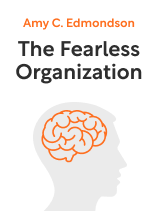

This article is an excerpt from the Shortform book guide to "The Fearless Organization" by Amy C. Edmondson. Shortform has the world's best summaries and analyses of books you should be reading.
Like this article? Sign up for a free trial here.
How do you define failure at work? Does failure have value in the workplace?
In The Fearless Organization, Amy C. Edmondson redefines the purpose of failure at work. This helps employees view their mistakes as opportunities to learn so the company can improve.
Learn more about why failure at work isn’t such a bad thing.
Redefine Failure
Redefining the purpose and value of failure at work can help employees view mistakes that they and others make not as problems to avoid at all costs and sweep under the rug, but as opportunities to improve their work and support their company in achieving its goals. Leaders can encourage employees to identify, address, and speak openly about mistakes and failure by redefining failure in the following ways:
1) Failure is a natural and valuable part of the learning process so long as you identify and analyze it after the fact to understand why things didn’t work, where they went wrong, and ways you can prevent the same problem from happening again.
2) Failure is a required part of experimental, investigatory, and exploratory processes that allow you to quickly move forward and figure out what solution works best.
(Shortform note: In Think Like a Rocket Scientist, Ozan Varol argues that rocket scientists have a complicated relationship with failure because while there’s little room for it when lives are at stake, taking scientific risks is a normal part of daily life in all other scenarios. He says that rocket scientists value “intelligent failure” (failure they can learn from) and approach failure with a genuine, disinterested curiosity.)
3) Failure is a warning sign that can avert preventable problems and disasters. (Shortform note: Experts agree that failing to create a safe space for employees to speak up about failure can lead to disaster, arguing that it’s time to retire the phrase, “Come to me with solutions, not problems.” But many managers stick with this line because a) they believe it empowers and helps employees “manage up” and b) they fear fostering a culture of whining.)
Example: Google X Celebrates Failure
Edmondson writes that Google X, an innovation lab parented by Alphabet, celebrates failure as part of the natural path to success. X CEO, Astro Teller, says the company believes that people have to fail to take big risks that lead to big innovations, and the faster that teams fail, the more quickly innovation can begin. To reflect this belief, the company established a set of now culturally-embedded practices that make failing safe, such as awarding promotions and bonuses to teams when they fail and holding an annual memorial service for failed projects to allow employees to say final, parting words to prototypes that didn’t make it.
(Shortform note: Some experts argue that the culture of celebrating failure has gone too far—to the point that companies are fetishizing it by default. They argue that while failure is unavoidable in some situations, it shouldn’t be glorified. Instead, we should fetishize learning that comes out of the process of innovating and taking risks. And while Edmondson highlights X’s celebration of failure, Teller is also averse to failure for failure’s sake: He has clarified that he expects about half of employees’ moon-shot ideas to work.)
Respond Appropriately to Undesirable Failure
While there’s value in destigmatizing failure, Edmondson says there are cases where employees fail in undesirable ways, such as making preventable mistakes or breaching company policies. She argues that when this happens, leaders must address the failure head on, and that doing so actually fosters a culture of psychological safety: Clarifying and enforcing company policies and expectations makes clear to staff that inappropriate behavior and actions that compromise the organization won’t be tolerated.
(In Crucial Accountability, Kerry Patterson, Joseph Grenny, et al. provide strategies to have accountability conversations that directly and humanely address problems while preserving reputations and relationships and achieving larger goals. After identifying the key problem you want to address, determine whether your motives for bringing up the problem are valid and if the issue is worth raising. As you prepare to enter the conversation, consider the other person’s point of view to ensure you don’t have an unnecessary bias that could taint your discussion. Finally, convey that you respect and share the same goals as the person you’re talking with to create a safe environment so they can open up and you can have a productive conversation.)
Edmondson points to a number of ways leaders can appropriately respond to undesirable failure scenarios:
1) If an employee makes a preventable mistake, increase training and improve systems to prevent the same mistake from happening again. (Shortform note: Experts recommend that when you provide training to employees in response to preventable mistakes, you should: a) explain how changes you’re asking them to make will result in improving their skill levels and success in the company; b) reinforce the company’s values by communicating how doing things properly saves the organization money and keeps customers happy; and c) congratulate them on helping the company meet its goals.)
2) If an employee repeatedly fails to adhere to, or actively violates, company protocols designed to prevent failures, fine, sanction, or fire that employee. This communicates to employees that harming the company’s mission, goals, and outcomes is unacceptable, and it demonstrates your company’s commitment to its values and policies—which reinforces a culture of psychological safety.
(Shortform note: Experts say that some managers find it difficult to hold employees accountable because they fear being disliked and don’t like confrontation. This can be particularly true for managers who are extroverts with a naturally high drive for social acceptance or managers with low dominance, who have a natural drive for harmony.)
3) If an employee makes a mistake in an area where the company has failed to outline clear protocols or procedures, examine organizational practices that led to the failure and remediate those conditions.
(Shortform note: Experts say if you’ve determined you need to implement a new policy to fill a gap that led to a failure, and you know what that policy is, you should do three things to ensure its implementation is successful: a) Garner support from stakeholders charged with implementing the policy; b) share information with employees about the policy—including why you’re implementing it—and encourage them to ask questions about it; and c) revise and update the policy as necessary.)

———End of Preview———
Like what you just read? Read the rest of the world's best book summary and analysis of Amy C. Edmondson's "The Fearless Organization" at Shortform.
Here's what you'll find in our full The Fearless Organization summary:
- The importance of psychological safety in the workplace
- How leaders and non-leaders can foster psychologically safe environments
- Why workers should be able to make mistakes without fear of reprisal






